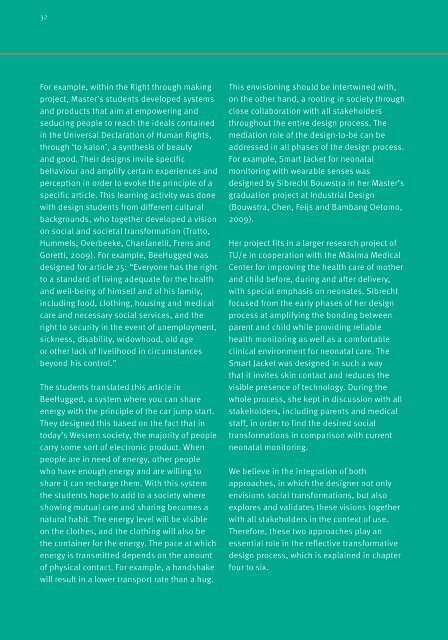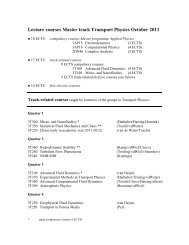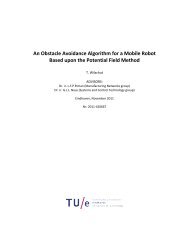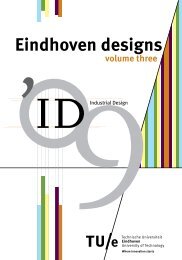Education guide 'Eindhoven designs' - Technische Universiteit ...
Education guide 'Eindhoven designs' - Technische Universiteit ...
Education guide 'Eindhoven designs' - Technische Universiteit ...
You also want an ePaper? Increase the reach of your titles
YUMPU automatically turns print PDFs into web optimized ePapers that Google loves.
32<br />
For example, within the Right through making<br />
project, Master’s students developed systems<br />
and products that aim at empowering and<br />
seducing people to reach the ideals contained<br />
in the Universal Declaration of Human Rights,<br />
through ‘to kalon’, a synthesis of beauty<br />
and good. Their designs invite specific<br />
behaviour and amplify certain experiences and<br />
perception in order to evoke the principle of a<br />
specific article. This learning activity was done<br />
with design students from different cultural<br />
backgrounds, who together developed a vision<br />
on social and societal transformation (Trotto,<br />
Hummels, Overbeeke, Chanfanelli, Frens and<br />
Goretti, 2009). For example, BeeHugged was<br />
designed for article 25: “Everyone has the right<br />
to a standard of living adequate for the health<br />
and well-being of himself and of his family,<br />
including food, clothing, housing and medical<br />
care and necessary social services, and the<br />
right to security in the event of unemployment,<br />
sickness, disability, widowhood, old age<br />
or other lack of livelihood in circumstances<br />
beyond his control.”<br />
The students translated this article in<br />
BeeHugged, a system where you can share<br />
energy with the principle of the car jump start.<br />
They designed this based on the fact that in<br />
today’s Western society, the majority of people<br />
carry some sort of electronic product. When<br />
people are in need of energy, other people<br />
who have enough energy and are willing to<br />
share it can recharge them. With this system<br />
the students hope to add to a society where<br />
showing mutual care and sharing becomes a<br />
natural habit. The energy level will be visible<br />
on the clothes, and the clothing will also be<br />
the container for the energy. The pace at which<br />
energy is transmitted depends on the amount<br />
of physical contact. For example, a handshake<br />
will result in a lower transport rate than a hug.<br />
This envisioning should be intertwined with,<br />
on the other hand, a rooting in society through<br />
close collaboration with all stakeholders<br />
throughout the entire design process. The<br />
mediation role of the design-to-be can be<br />
addressed in all phases of the design process.<br />
For example, Smart Jacket for neonatal<br />
monitoring with wearable senses was<br />
designed by Sibrecht Bouwstra in her Master’s<br />
graduation project at Industrial Design<br />
(Bouwstra, Chen, Feijs and Bambang Oetomo,<br />
2009).<br />
Her project fits in a larger research project of<br />
TU/e in cooperation with the Máxima Medical<br />
Center for improving the health care of mother<br />
and child before, during and after delivery,<br />
with special emphasis on neonates. Sibrecht<br />
focused from the early phases of her design<br />
process at amplifying the bonding between<br />
parent and child while providing reliable<br />
health monitoring as well as a comfortable<br />
clinical environment for neonatal care. The<br />
Smart Jacket was designed in such a way<br />
that it invites skin contact and reduces the<br />
visible presence of technology. During the<br />
whole process, she kept in discussion with all<br />
stakeholders, including parents and medical<br />
staff, in order to find the desired social<br />
transformations in comparison with current<br />
neonatal monitoring.<br />
We believe in the integration of both<br />
approaches, in which the designer not only<br />
envisions social transformations, but also<br />
explores and validates these visions together<br />
with all stakeholders in the context of use.<br />
Therefore, these two approaches play an<br />
essential role in the reflective transformative<br />
design process, which is explained in chapter<br />
four to six.

















